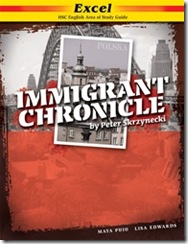I received an email the other day; naturally the first part I find very pleasing. 🙂
I thought about creating an ESL blog for my students, but now conclude that this is not necessary as your site does it all. I passionately support all your ideas on this site and applaud your remarkable work. I am an ESL/English teacher in a … non-selective independent high school. Even though I graduated with HD from my uni ESL program five years ago, I have been using my scales and teaching ESL for only the last year and I am overwhelmed with the learning needs of my students. I am from a NESB [myself], but I do not speak the first language of the students.
My school is currently going through a learning support review and I would like to seek your wisdom. The school has found that students entering from language colleges cannot cope with the demands of our curriculum. Some students have learning difficulties as well as a language barrier. What type of ESL delivery has worked best at SBHS?
Well, I doubt how much wisdom I might have, but I am glad this site has met a need.
To take the last part first: SBHS no longer has an ESL teacher, and I am retired aside from the odd job here or there, and some tuition work, but even when I was ESL teacher as SBHS we didn’t confront problems of the kind the writer mentions, as there were no overseas fee-paying students at the school and only very occasionally did someone come from an Intensive English school to us. Mostly they had already been a few years at least in an English-speaking educational setting. There were some students who had been speaking English for three years or less, however, who fell well within the five to eight years normally required to attain adequate levels of cognitive academic language proficiency.
The writer is correct in saying that some “students entering from language colleges cannot cope with the demands of our curriculum”. I base this on my tuition work rather than on my work at SBHS. It does seem that there is a mismatch between the levels students from some private language colleges attain and the basic level needed even to function in a mainstream school environment, which I would say has to be at least Australian ESL Scales 4; 5 or 6 in some subjects, even in HSC English ESL, if a decent result is to be gained. I should add that many private colleges do an excellent job, and the NSW Intensive English schools for state school students are particularly good.
Some schools have good ESL support structures; one that I know of actually runs its own ELICOS classes for newly arrived overseas students, affording limited or phased participation in mainstream classes until the right level is reached. Others have sufficient numbers of overseas students to allow targeted classes in mainstream curriculum designed for those students in many subjects, while others rely on traditional forms of ESL support such as regular presence of one or more ESL teachers in various curriculum areas, and cooperative planning of work units with the students’ language needs consciously addressed.
There is an ESL strategy document available from the NSW Department of Education that gives many good pointers, but how effective a particular school can be depends on the human and other resources it can afford. You probably know it but here it is: English as a Second Language: Guidelines for Schools (PDF).
One thing is for sure. Some schools may have, I believe, gone into the overseas student business, which is very profitable, without being fully aware of the social, logistical and educational issues involved.
When I was at SBHS I tested all new students, gathered information about them, and assessed their needs from an ESL viewpoint. This material was shared with classroom teachers. Particular cases were discussed with teachers. Some students were interviewed and given some additional tuition in some cases. With some classes I visited in various subject areas, participating in some lessons. Sometimes teachers would refer certain issues to me. This blog in its original form was a way of reaching more students than I could personally.
 … but I am prepared to laud Maya Puiu and Lisa Edwards for their Pascal Press Study Guide for “Belonging” and Peter Skrzynecki’s Immigrant Chronicle. It really is a thorough and extremely intelligent guide.
… but I am prepared to laud Maya Puiu and Lisa Edwards for their Pascal Press Study Guide for “Belonging” and Peter Skrzynecki’s Immigrant Chronicle. It really is a thorough and extremely intelligent guide.


 At one of those cheap remainder bookshops I picked up a copy of
At one of those cheap remainder bookshops I picked up a copy of 




